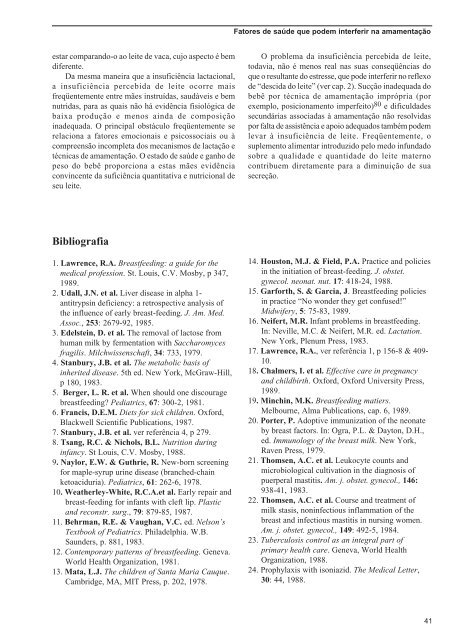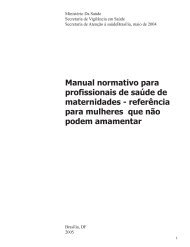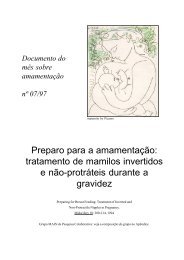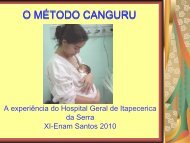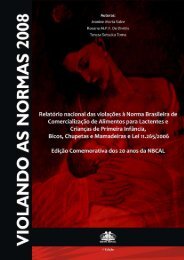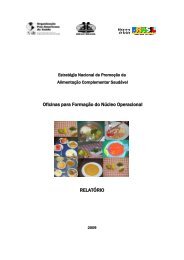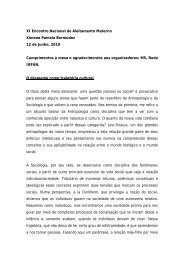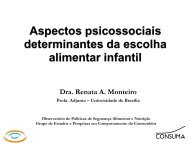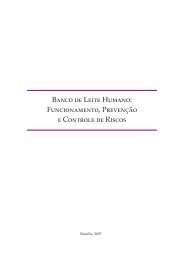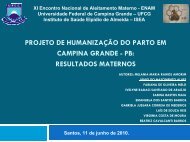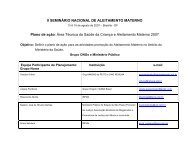Alimentação infantil: bases fisiológicas - IBFAN Brasil
Alimentação infantil: bases fisiológicas - IBFAN Brasil
Alimentação infantil: bases fisiológicas - IBFAN Brasil
Create successful ePaper yourself
Turn your PDF publications into a flip-book with our unique Google optimized e-Paper software.
Fatores de saúde que podem interferir na amamentação<br />
estar comparando-o ao leite de vaca, cujo aspecto é bem<br />
diferente.<br />
Da mesma maneira que a insuficiência lactacional,<br />
a insuficiência percebida de leite ocorre mais<br />
freqüentemente entre mães instruídas, saudáveis e bem<br />
nutridas, para as quais não há evidência fisiológica de<br />
baixa produção e menos ainda de composição<br />
inadequada. O principal obstáculo freqüentemente se<br />
relaciona a fatores emocionais e psicossociais ou à<br />
compreensão incompleta dos mecanismos de lactação e<br />
técnicas de amamentação. O estado de saúde e ganho de<br />
peso do bebê proporciona a estas mães evidência<br />
convincente da suficiência quantitativa e nutricional de<br />
seu leite.<br />
O problema da insuficiência percebida de leite,<br />
todavia, não é menos real nas suas conseqüências do<br />
que o resultante do estresse, que pode interferir no reflexo<br />
de “descida do leite” (ver cap. 2). Sucção inadequada do<br />
bebê por técnica de amamentação imprópria (por<br />
exemplo, posicionamento imperfeito) 80 e dificuldades<br />
secundárias associadas à amamentação não resolvidas<br />
por falta de assistência e apoio adequados também podem<br />
levar à insuficiência de leite. Freqüentemente, o<br />
suplemento alimentar introduzido pelo medo infundado<br />
sobre a qualidade e quantidade do leite materno<br />
contribuem diretamente para a diminuição de sua<br />
secreção.<br />
Bibliografia<br />
1. Lawrence, R.A. Breastfeeding: a guide for the<br />
medical profession. St. Louis, C.V. Mosby, p 347,<br />
1989.<br />
2. Udall, J.N. et al. Liver disease in alpha 1-<br />
antitrypsin deficiency: a retrospective analysis of<br />
the influence of early breast-feeding. J. Am. Med.<br />
Assoc., 253: 2679-92, 1985.<br />
3. Edelstein, D. et al. The removal of lactose from<br />
human milk by fermentation with Saccharomyces<br />
fragilis. Milchwissenschaft, 34: 733, 1979.<br />
4. Stanbury, J.B. et al. The metabolic basis of<br />
inherited disease. 5th ed. New York, McGraw-Hill,<br />
p 180, 1983.<br />
5. Berger, L. R. et al. When should one discourage<br />
breastfeeding? Pediatrics, 67: 300-2, 1981.<br />
6. Francis, D.E.M. Diets for sick children. Oxford,<br />
Blackwell Scientific Publications, 1987.<br />
7. Stanbury, J.B. et al. ver referência 4, p 279.<br />
8. Tsang, R.C. & Nichols, B.L. Nutrition during<br />
infancy. St Louis, C.V. Mosby, 1988.<br />
9. Naylor, E.W. & Guthrie, R. New-born screening<br />
for maple-syrup urine disease (branched-chain<br />
ketoaciduria). Pediatrics, 61: 262-6, 1978.<br />
10. Weatherley-White, R.C.A.et al. Early repair and<br />
breast-feeding for infants with cleft lip. Plastic<br />
and reconstr. surg., 79: 879-85, 1987.<br />
11. Behrman, R.E. & Vaughan, V.C. ed. Nelson’s<br />
Textbook of Pediatrics. Philadelphia. W.B.<br />
Saunders, p. 881, 1983.<br />
12. Contemporary patterns of breastfeeding. Geneva.<br />
World Health Organization, 1981.<br />
13. Mata, L.J. The children of Santa Maria Cauque.<br />
Cambridge, MA, MIT Press, p. 202, 1978.<br />
14. Houston, M.J. & Field, P.A. Practice and policies<br />
in the initiation of breast-feeding. J. obstet.<br />
gynecol. neonat. nut. 17: 418-24, 1988.<br />
15. Garforth, S. & Garcia, J. Breastfeeding policies<br />
in practice “No wonder they get confused!”<br />
Midwifery, 5: 75-83, 1989.<br />
16. Neifert, M.R. Infant problems in breastfeeding.<br />
In: Neville, M.C. & Neifert, M.R. ed. Lactation.<br />
New York, Plenum Press, 1983.<br />
17. Lawrence, R.A., ver referência 1, p 156-8 & 409-<br />
10.<br />
18. Chalmers, I. et al. Effective care in pregnancy<br />
and childbirth. Oxford, Oxford University Press,<br />
1989.<br />
19. Minchin, M.K. Breastfeeding matiers.<br />
Melbourne, Alma Publications, cap. 6, 1989.<br />
20. Porter, P. Adoptive immunization of the neonate<br />
by breast factors. In: Ogra, P.L. & Dayton, D.H.,<br />
ed. Immunology of the breast milk. New York,<br />
Raven Press, 1979.<br />
21. Thomsen, A.C. et al. Leukocyte counts and<br />
microbiological cultivation in the diagnosis of<br />
puerperal mastitis. Am. j. obstet. gynecol., 146:<br />
938-41, 1983.<br />
22. Thomsen, A.C. et al. Course and treatment of<br />
milk stasis, noninfectious inflammation of the<br />
breast and infectious mastitis in nursing women.<br />
Am. j. obstet. gynecol., 149: 492-5, 1984.<br />
23. Tuberculosis control as an integral part of<br />
primary health care. Geneva, World Health<br />
Organization, 1988.<br />
24. Prophylaxis with isoniazid. The Medical Letter,<br />
30: 44, 1988.<br />
41


